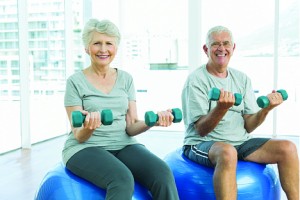 Did you know that as many as 75% of us will have some form of back or neck pain at some point in our lifetime? Fortunately for most of us we will recover without surgery; in fact according to a new study physical therapy for spinal stenosis is as effective as surgery and should be considered as a first-choice treatment option.
Did you know that as many as 75% of us will have some form of back or neck pain at some point in our lifetime? Fortunately for most of us we will recover without surgery; in fact according to a new study physical therapy for spinal stenosis is as effective as surgery and should be considered as a first-choice treatment option.
Spinal stenosis is a narrowing of the vertebrae within the spinal column which places too much pressure on either the spinal cord itself or peripheral nerves. Stenosis can occur in the neck or the lower back. But what causes spinal stenosis? There are two types of stenosis, one is congenital or present at birth and the other type is acquired or has onset at a later time in a patient’s life. For acquired stenosis the most common causes are:
• Osteoarthritis which causes a deterioration of the cartilage between the joints. When this happens, the body’s response is to form additional bone – called “bone spurs” – in order to add support to the damaged area. These spurs sometimes irritate or cause pressure on nerves as they exit the spinal canal.
• Normal aging can also result in a flattening of the disks that provide cushioning between each set of vertebrae. The reduced space allows less room for the nerve to exit from the spinal cord and if the disk itself is damaged sometimes pieces of disc material will cause pressure on the nerves.
In most cases these symptoms can be effectively managed with physical therapy and other conservative treatments.
At this point you may be wondering what are the symptoms of spinal stenosis. Interestingly, if you have stenosis in your neck, you may not have any pain in your neck but instead may suffer from pain in your arms and/or legs, along with weakness and numbness depending on which nerves are affected. If the stenosis is in your low back, you may have pain, numbness and weakness in your low back and legs and your symptoms may get worse when you walk and better when you sit. That being the case, these seem to be some generally age-related symptoms, don’t they? That’s where a careful diagnosis from either your physician or physical therapist is important. Your therapist will conduct a thorough evaluation, including a review of your medical history. The evaluation may include:
• Tests of muscle strength and sensation to determine the severity of the pressure on your nerves
• Measure the range of motion of your arms, legs and spine
• Use of manual therapy to evaluate the mobility of your joints and the muscles in your spine
• Examination of your posture and observation of how you walk and perform other activities
OK, now you have the diagnosis, so what’s next? Your physical therapist and/or occupational therapist’s job is to help you get back to participating in your daily life and activities, so they will design a treatment plan based on the evaluation and your goals. This will be accomplished through a combination of different activities:
• Here at Florida Movement Therapy Centers we have the exclusive GIGERMD medical device which, due to the way that you are virtually weightless on the unit, allows for decompression of the spine and dynamic traction.
• Stretching and flexibility exercises to improve mobility in the joints and muscles of your spine and extremities. Improving motion in a joint is often the key to pain relief!
• Strengthening exercises – strong trunk muscles provide support for your spinal joints and strong arm and leg muscles take some of the workload off your spinal joints
• Manual therapy to improve the mobility of stiff joints that could be contributing to your symptoms
• Pain treatments, such as ice or electrical stimulation for pain that is severe and not relieved by exercise or manual therapy
Spinal stenosis is usually a natural result of aging, research has not shown us a way yet to prevent it! However, you can make some choices that the impact of stenosis or even slow its progression:
• Regular exercise strengthens the muscles that support your back, keeps your joints flexible and helps maintain a healthy body weight; all of these help reduce wear and tear on the spine.
• Using supportive chairs and mattresses and avoid activities that lead to injury, such as heavy lifting – can help protect your back.
Your therapist will help develop a fitness program that takes your stenosis into account as there are some exercises that are better than others for patients with this condition. For example, since walking can be painful, bicycling may be a better way to get your exercise. Physical therapists are prepared through education and experience to treat people who have spinal stenosis. Remember, for most patients it’s a better and safer choice than surgery!
Florida Movement Therapy
BOYNTON BEACH
561.733.5083
12040 South Jog Rd. 33437
BOCA RATON
561.883.7800
21065 Powerline Road 33433
Check Also
Trusted Homecare Agency: Serving Veterans with Free Supplemental Home Healthcare
When it comes to healthcare, veterans deserve the best care possible. For veterans seeking in-home …
 South Florida Health and Wellness Magazine Health and Wellness Articles
South Florida Health and Wellness Magazine Health and Wellness Articles




